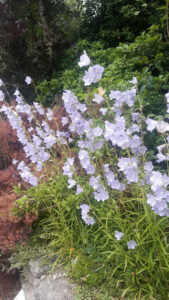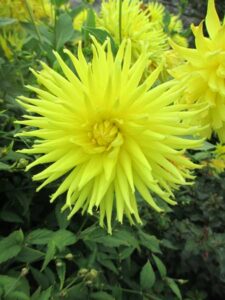Gardening
with Charlie Wilkins
RED ROBIN CHARM
In sombre, darkened gardens,(due perhaps to the shade set by buildings, shrubbery, or street planting) it is possible to depend solely on leaves to provide light, colour, interest, and movement, apart altogether from any blooms which may be produced. In fact, good foliage can be far better than the rather ephemeral blooms produced on most trees and shrubs.
In Japan, the one country where gardening was always regarded as one of the fine arts (reaching a degree of sophistication it has never really attained in Europe), foliage has always been regarded as being more important than flower.
Given that it can be quite difficult to choose modest sized trees with good foliage for today’s smaller, and more compact gardens, we are obliged to turn to hedging and shrubs with an interesting coloured leaf.
A number of these can burgeon out in delicate shades of red or vivid lemon instead of green, and of these, the one which outshines all the others is the easily recognized Photinia fraseri ‘Red Robin’ boasting highly polished, floor-tile coloured waxy-how they are pruned and trained. Like hawthorn, they will in time produce flowers, but not until the large, laurel-like leaves have in their maturity turned a deep mid-green. In infancy and in youth however, these are admired for their rich red gloss and it is these that the gardener wants to encourage and maintain. This is achieved by pruning (and the training of wayward shoots when being grown as a hedge) but the big question is “when does the actual reduction, pruning, and training take place?
At a recent presentation, I suggested the period early September (just as the semi-mature leaves begin to put on a green appearance) as the optimum time for just such an undertaking. Done then, the plants will have enough time to put out fresh new growth, making a splendid addition to the early autumn garden. Do no further pruning during either autumn or winter, tidying the plants only when spring arrives.
A sunny site is probably best in encouraging this shrub to produce the best results. Any reasonable garden soil will suffice but please avoid heavy clay. The shrub is generally totally hardy but sometimes, the young foliage tips can be burned by severe late spring frosts.
Cuttings of Red Robin are best taken during mid-summer and if placed in a free draining compost should be well rooted by late autumn. Allow three years before you have a proper plant which can develop into an impressive clump, but the delay is worthwhile. Grown as a hedge, Red Robin will be found to have all the virtues and none of the vices usually associated with hedges such as laurel.

AUTUMN WELCOME
Autumn, as in every year, is the most contradictory of seasons! It has far more warmth and sunshine than is popularly allowed and was particularly evident this year in the glorious months of August and September. As a season, it is profoundly senescent and sweet smelling of corruption, but sadly, also filled with treasured departures.
Whether we greet, or detest its arrival, it is as inescapable as winter. It begins, traditionally in the month of August, but as the days move into September and October they become noticeably shorter and indeed cooler. Flowers seem to sense the change and try their utmost to produce as much seed as possible in the hope that their offspring, will next year be more bountiful than themselves.
The first garden indications of autumn are the early morning cobwebs strung from every shrub and perennial. The handiwork of the Orb spider, these webs are creations of wonder and beauty, the intricate designs showing up readily on dew-laden mornings. For all that, it’s the chilling of the air, and a clinging dampness creeping up from the soil that alerts the gardener to the distinct change of atmosphere, not to mention the arrival of oddly familiar, and sometimes strange scents.
Rripeness is the key element to these powerful odours: mixtures of plenty and decay. They also contain remnants (and memories) of a waning summer left in the fragrance of roses, lilies, marigolds, chocolate cosmos, dahlias, phlox, and agapanthus. All these, mixed with the sugar-sweet aroma which rises now from scarified and recovering lawns. (That severe heat played havoc with well-tended swards.)
Yet I love these smells, many with their subtle, musky, rotting aromatic exhalation, but I prefer to contemplate what lies ahead now instead of retiring and sulking over those lost and decidedly past their best. There really is no future in the past.
So, I welcome now the predominance of pastel shades, coupled with soft blue, for these give an incredible lift to the entire garden. When deep colours begin to recede into the darkness, pale blues and indeed whites glow with subtle illumination.
I have found this illumination to be particularly powerful with the mauve-blue of Geranium ‘Jolly Bee’ and the superior lace cap blooms of Hydrangea villosa, both of which maintain a ghostly gleam until darkness finally descends. Delicate pastel shades on the last Campanula lactiflora plantings also hold out well against the twilight. All campanulas are similarly endowed.
Of course, white will readily grace any garden at sunset and indeed long after. A white garden is an exciting place to wander through on warm evenings especially when there is a full moon due. Nothing of consequence beats the mophead hydrangeas for evening impact and the generous billowing clouds of Madame Emile Mouillere are outstanding for sustaining pools of brightness well into the night. The same can be said about the rather drooping ‘Annabel’ whose creamy blooms are as large as sticks of candy floss and equally as soft.







